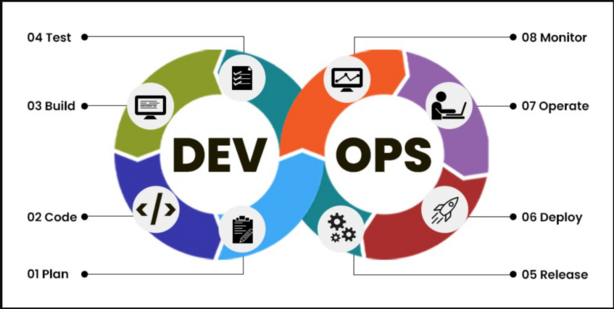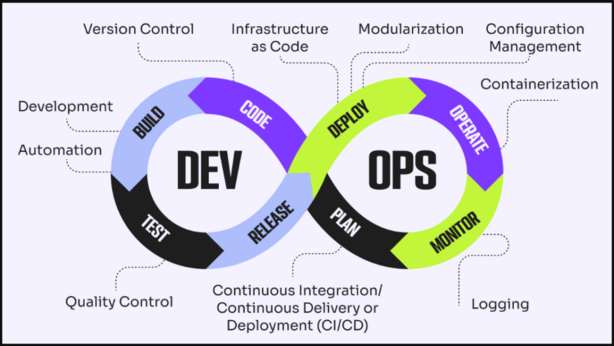Upgrade & Secure Your Future with DevOps, SRE, DevSecOps, MLOps!
We spend hours on Instagram and YouTube and waste money on coffee and fast food, but won’t spend 30 minutes a day learning skills to boost our careers.
Master in DevOps, SRE, DevSecOps & MLOps!
Learn from Guru Rajesh Kumar and double your salary in just one year.

Network operations traditionally involve monitoring, configuring, and maintaining a company’s network infrastructure. As network environments become increasingly complex with cloud, hybrid, and distributed systems, managing networks effectively requires advanced tools and processes. This is where DevOps comes into play.
DevOps, known for fostering collaboration, automation, and continuous improvement in software development and operations, can significantly enhance network operations. By integrating DevOps principles into network management, businesses can achieve greater automation, better scalability, faster incident response, and more efficient network configurations. This post explores how DevOps practices can optimize network operations, ensuring network reliability and efficiency.
Key Benefits of Using DevOps for Network Operations
Integrating DevOps into network operations offers several benefits, from improved collaboration between teams to automation and enhanced security. By leveraging DevOps tools and practices, network operations teams can address challenges more effectively.
Key Benefits Include:
- Increased Automation:
- DevOps introduces automation into network operations, reducing the need for manual configuration and management tasks.
- Tools like Ansible and Terraform enable teams to automate the configuration of network devices, provisioning of network resources, and deployment of network services.
- Faster Issue Detection and Resolution:
- Continuous monitoring tools integrated into DevOps pipelines help detect network issues early, minimizing downtime and performance degradation.
- Automated incident response allows for faster remediation, ensuring that network issues are addressed promptly without manual intervention.
- Enhanced Collaboration:
- DevOps promotes collaboration between development, operations, and network teams, fostering a shared responsibility for network performance and reliability.
- Cross-functional teams work together to resolve network issues, improve configurations, and optimize network performance.
- Scalability and Flexibility:
- As businesses scale, network operations must evolve to accommodate increased demands. DevOps practices provide the flexibility to scale network resources up or down as needed, ensuring optimal performance.
- Cloud-based tools like AWS, Azure, and Google Cloud integrate with DevOps practices to enable elastic scalability of network resources.
- Improved Security and Compliance:
- DevOps can help automate security configurations and ensure compliance with industry standards through continuous audits and monitoring.
- Automated security checks help identify vulnerabilities or misconfigurations that could potentially disrupt network operations.

Key DevOps Practices for Network Operations
Several DevOps practices directly enhance network operations by improving efficiency, reliability, and agility. These practices help streamline network management tasks, from configuration to monitoring.
Key DevOps Practices Include:
- Infrastructure as Code (IaC):
- Infrastructure as Code allows network configurations and resources to be defined using code, making the setup and management of network infrastructure more efficient and repeatable.
- Tools like Terraform, Ansible, and Puppet allow teams to automate network configurations, reducing the risk of human error and ensuring consistency across the network.
- Continuous Integration and Continuous Deployment (CI/CD):
- In network operations, CI/CD can be applied to the deployment and configuration of network devices and services.
- Automated testing and deployment of configurations help ensure that network changes are implemented without introducing new issues or disruptions.
- Continuous Monitoring and Feedback:
- Continuous monitoring is essential to identify performance bottlenecks, failures, or vulnerabilities within the network.
- DevOps practices ensure that real-time data is collected and analyzed from network devices, providing actionable insights that drive continuous improvement and proactive incident management.
- Automated Incident Response:
- DevOps automation helps with incident detection and automated remediation. For example, network tools like Nagios or Datadog can trigger automatic alerts and responses when an anomaly is detected in network performance.
- Automated workflows can address issues such as network congestion, service failures, or security threats, ensuring rapid recovery and minimal downtime.
- Collaboration and Communication Tools:
- DevOps encourages the use of tools like Slack, Jira, or Microsoft Teams to facilitate real-time communication between network operations teams, developers, and other stakeholders.
- By leveraging these tools, teams can share updates on network performance, incident status, and network changes, improving collaboration during incident resolution and ongoing network management.
Automating Network Configuration and Management
One of the key advantages of DevOps in network operations is the ability to automate configuration and management tasks. Automation reduces the manual effort involved in setting up and managing network infrastructure and services, ensuring that network configurations are consistent and reliable.
Automating Network Configuration:
- Network Configuration as Code:
- Network configurations, including IP addresses, routing protocols, and device settings, can be managed as code using tools like Ansible or Terraform.
- This allows for version-controlled configurations that can be easily replicated across multiple network devices, ensuring consistency and reducing the risk of errors.
- Automated Device Provisioning:
- Automation tools can be used to provision new network devices, such as switches, routers, or firewalls, with pre-defined configurations.
- This speeds up the setup process, ensuring that devices are correctly configured before being added to the network, reducing manual configuration errors.
- Dynamic Network Configuration Updates:
- With DevOps, network configuration updates can be automatically pushed to devices as part of an automated deployment pipeline.
- This ensures that network configurations are always up-to-date and aligned with the latest requirements or security patches.
- Automated Scaling:
- DevOps tools enable automatic scaling of network resources based on demand, ensuring that network performance remains optimal during periods of high traffic.
- Tools like Kubernetes and AWS Auto Scaling integrate with network configurations to automatically add or remove resources based on traffic patterns.
Real-Time Network Monitoring and Incident Detection
Real-time monitoring is essential for proactive network management. DevOps practices help integrate continuous monitoring and alerting into network operations, enabling teams to detect incidents early and resolve them before they impact users.
Real-Time Monitoring and Incident Detection:
- Continuous Performance Monitoring:
- Tools like Prometheus, Nagios, and Zabbix continuously monitor the performance of network devices and services, tracking metrics such as latency, bandwidth usage, and packet loss.
- This monitoring provides real-time visibility into network performance, allowing teams to identify and address issues quickly.
- Log Aggregation and Analysis:
- Log aggregation tools like ELK Stack (Elasticsearch, Logstash, Kibana) or Splunk help collect and analyze log data from network devices, servers, and applications.
- By analyzing logs in real-time, DevOps teams can detect anomalies, configuration errors, or security incidents that could lead to network outages or performance issues.
- Anomaly Detection and Alerts:
- DevOps tools like Datadog and New Relic can detect anomalies in network traffic or system behavior using machine learning and AI-based algorithms.
- Automated alerts are triggered when abnormal behavior is detected, enabling teams to respond quickly to potential incidents.
- Predictive Analytics for Network Health:
- By analyzing historical data, DevOps teams can predict network issues before they happen, based on patterns and trends.
- Predictive analytics helps identify potential points of failure and enables teams to take preventive action to avoid future incidents.
Scaling Network Operations with DevOps
As businesses grow, so do the demands on their network infrastructure. DevOps practices enable teams to scale network operations efficiently, ensuring that network resources are flexible and responsive to changes in traffic, demand, and system complexity.
Scaling Network Operations:
- Elastic Scaling of Network Resources:
- Cloud platforms like AWS, Azure, and Google Cloud allow DevOps teams to scale network resources up or down automatically based on demand.
- This ensures that network performance remains consistent during periods of high traffic, while avoiding resource wastage during periods of low demand.
- Infrastructure as Code for Scalable Networks:
- DevOps tools like Terraform allow network configurations to be treated as code, enabling teams to easily scale and modify network resources across cloud or on-premise environments.
- This makes it easier to deploy new network services, extend network capacity, and manage resources dynamically.
- Containerized Networking:
- With Docker and Kubernetes, DevOps teams can create containerized applications that can be scaled horizontally across multiple network nodes.
- This flexibility allows for the efficient allocation of network resources and helps avoid bottlenecks as workloads increase.
- Auto-Scaling Network Services:
- DevOps practices enable the automation of network service scaling, such as load balancers, firewalls, and DNS servers, based on real-time traffic and performance metrics.
- This ensures that services remain available and perform optimally, regardless of traffic fluctuations.
DevOps Enhances Network Operations
By applying DevOps principles to network operations, organizations can achieve higher levels of automation, scalability, and performance monitoring. Continuous monitoring, automated configuration, real-time incident detection, and collaboration between teams are all essential components of a successful DevOps-enabled network management strategy.
DevOps enables teams to address the complexity of modern networks, from cloud infrastructure to hybrid environments, while ensuring reliability and scalability. As network demands continue to grow, DevOps provides the tools and practices necessary to meet these challenges and maintain optimal performance.